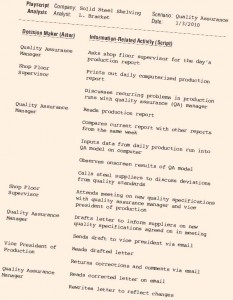Observing decision makers, their physical environment, and their interaction with their physical, ergonomic environment is an important unobtrusive method for the systems analyst. Through observing activities of decision makers, the analyst seeks to gain insight about what is actually done, not just what is documented or explained. In addition, through observation of the decision maker, the analyst attempts to see firsthand the relationships that exist between decision makers and other organizational members. Observation of decision makers’ interactions with technologies can also reveal important clues regarding HCI concerns, such as how well the system fits with the user.
Observing a Typical Manager’s Decision-Making Activities
Managers’ workdays have been described as a series of interruptions punctuated by short bursts of work. In other words, pinning down what a manager “does” is a slippery proposition even under the best of circumstances. For the systems analyst to grasp adequately how managers characterize their work, interactive interviews and questionnaires are used. Observation, however, allows the analyst to see firsthand how managers gather, process, share, and use information and technology to get work done.
Although it is possible to describe and document how managers make decisions using boxes and arrows, we are primarily describing humans and their activities. Therefore, we suggest that systems analysts use a more humanistic approach to describe what managers do. This method is called the analyst’s playscript. With this technique the “actor” is the decision maker who is observed “acting” or making decisions. In setting up a playscript, the actor is listed in the left-hand column and all his or her actions are listed in the right-hand column, as shown in Figure 5.7. All activities are recorded with action verbs, so that a decision maker would be described as “talking,” “sampling,” “corresponding,” and “deciding.”

Playscript is an organized and systematic approach that demands the analyst be able to understand and articulate the action taken by each observed decision maker. This approach eventually assists the systems analyst in determining what information is required for major or frequent decisions made by the observed people. For instance, from the quality assurance manager example in the playscript, it becomes clear that even though this decision maker is on the middle management level, he or she still requires a fair amount of external information to perform the required activities of this specific job.
Contents
